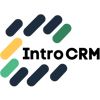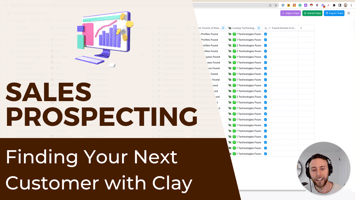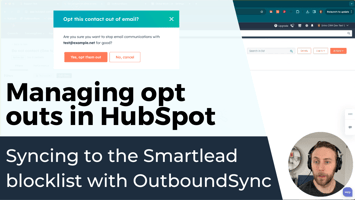Did you know that you can use regular expressions (regex) or formulas in Clay to extract text, do...
Trade show follow-up email at scale
If you just finished a trade show and have a list of leads that you need to follow up with... You don't have to rely on the data you have.
In this example campaign we increased reply rate by 172% from 2% to 27% by taking a programmatic approach to enriching and segmenting the list.
We specifically use Clay to access LinkedIn, Google, and other data to find out about the company's size, job openings, and other traits.
We needed to have a domain and email address ready to send -- and a team standing by ready to handle the replies.
We also evaluate the specific copywriting we used for the email itself. We didn't use any templates to write this trade show follow up. Instead, we did some copywriting and relied heavily on the data for our best-fit ICP prospects on the list.
Then we compared the two sequences and got much better results.
Transcript
[00:00:00] Introduction
---
[00:00:00] Harris Kenny: I want to show you how we took a list of leads from a B2B trade show, segmented it and improved the response rate from 2% to 27%. If you compare the two different approaches.
[00:00:10] Harris Kenny: First, this is not a clean experiment. We are specifically trying to find the best leads that we can focus on them and we're using software to do that.
[00:00:18] Harris Kenny: And the second is that this is not the best way to run this campaign. I am sure that there are ways that we could improve the copy and make it better in the future.
[00:00:25] Harris Kenny: Question is, are we getting better every day? Are we doing better than we would do otherwise?
[00:00:30] Building the list
---
[00:00:30] Harris Kenny: We've got a list of 58 leads from marketing. These are from a B2B food and beverage event. We've got the name, email, title, and company. Way a lot of companies do this is they take this list, load it into a mass marketing tool. And then just use the variables or the data that they have available to maybe do like a hi first name, or it was nice learning about your company and send out the campaign.
[00:00:53] Harris Kenny: What we're doing is something a little bit different. We're going to be segmenting that list and trying to find the best fit prospects and then sending them a different message and approaching them in a fundamentally different way. In order to know who's the best fit. We don't have a lot of information here. So we're going to go to clay and we're going to get their domain, their industry, employee, head count location, number of open jobs and the specific jobs that they're hiring for.
[00:01:15] Enriching the list
---
[00:01:15] Harris Kenny: I'm just going to note really quickly here that we do not have all the information here. I've got some of it. What you need to know for the purposes of this video, but prospect contact information is not included here.
[00:01:27] Harris Kenny: Partial view of getting the domain, extracting that domain, and then using that to find the LinkedIn profile. Here's a look at what that LinkedIn data that clay makes available to us. We're going to use a couple of fields here. There's a lot more, but we're going to use basics to really just find that headcount range, because we're going to use that as a proxy for size.
[00:01:45] Harris Kenny: 12 out of the 58 leads are a good fit in terms of size. We've got their location, which we're going to pull on later. And then we're using Google to search to see what they're hiring for. Now you can find the specific results that Google is pulling up. And then the specific jobs. Now you see some of this text is going to be all caps. We're going to be able to normalize that later, either with Clay's workflows or with red jacks. So don't worry about that, but that is something you want to make sure that you look at before sending.
[00:02:13] Campaign preparation
---
[00:02:13] Harris Kenny: And we've got our 20%. There's two other bookends to this that I just want to mention upfront. You want to have that dedicated domain and you want to have it configured correctly, warmed up and ready to go for this type of campaign. So the emails land in the inbox, and the second thing is that you need to be ready to handle the replies.
[00:02:31] Harris Kenny: Our team is on standby. We handle replies like this. In addition to setting up the campaign, we actually helped manage the replies and then booking the meeting with account executives. So you want to make sure you have that taken care of as well.
[00:02:42] Writing the copy
---
[00:02:42] Harris Kenny: Now a buddy of mine, who I learned a lot from is Jordan Crawford. And he encouraged me to include more campaign copy. So I've got some snippets in here, not the full sequence. I'm just going to notice some structural changes or differences between the two campaigns. So the first is the generic messaging.
[00:02:56] Harris Kenny: It's a simple email that we did run through lavender. And we are following good practices there, but it's just a single email to everybody else that attended. On the right, we've got some snippets of that programmatically generated information that we got through clay that we're going to include in the email.
[00:03:11] Harris Kenny: This also ran through lavender, and this is going to be running over the course of a month, three separate emails with really different messages in each email. To a much smaller list with speaking to the position that they are at in their business.
[00:03:25] Campaign results
---
[00:03:25] Harris Kenny: And how did it go? We've got much better results. So the generic list only had a 2% reply rate and the cherry picked list of the best fit. We got a 27% reply rate.
[00:03:35] Harris Kenny: I would like to see this be higher. I think that as this sequence works through, and as we get a chance to reengage with these prospects, we're going to eventually see more engagement. But in general, I think that the programmatic approach did generate better results. And I think that we have room to improve in the future. As this company does a lot of trade shows and we're going to have a lot of different ideas that we can test.
[00:03:54] Harris Kenny: Let me know what you think, what you do differently, and I appreciate you watching. Thanks.



